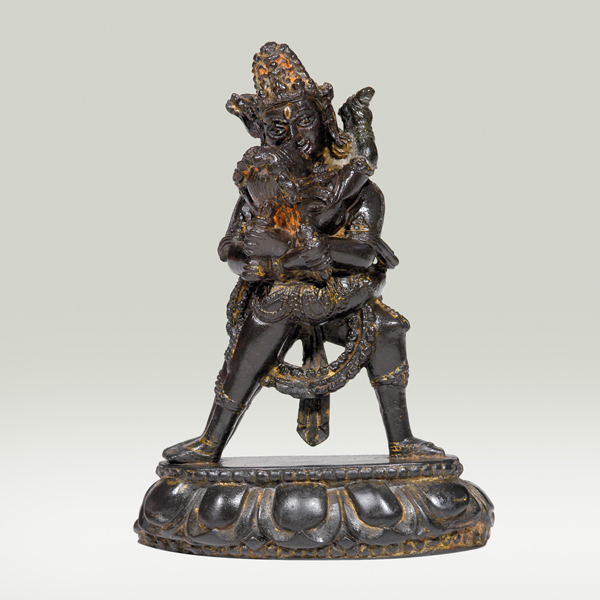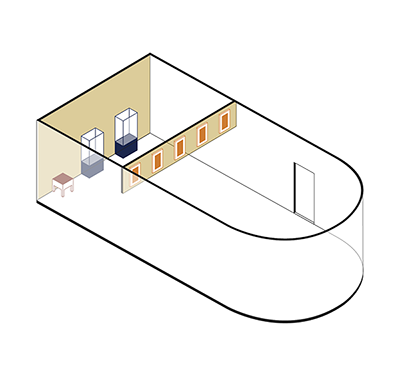ABS 248
Code: ABS 248
Country: India (north-east)
Style: Late Pala Style
Date: 1000 - 1100
Dimensions in cm WxHxD: 7.2 x 10.3 x 2.5
Materials: Stone with remains of pigments
Chakrasamvara embracing Vajravarahi
The yidam Chakrasamvara stands in the warrior stance on a lotus throne, his right leg extended and his left bent. He is united with his consort Vajravarahi. His hands are crossed behind her back, holding the diamond sceptre (vajra) and the bell (ghanta). He wears the macabre attributes of the charnel grounds: the loincloth of tiger skin, the bone ornaments and the crown of dried skulls. A wide sash is swirling around him. Vajravarahi embraces him, her right leg wrapped around his waist and her left arm around his neck. She holds the skull bowl and brandishes the curved blade of the flaying knife. As they stride out, the two step on the deities Bhairava and Kalaratri. Turquoises and lapis lazuli adorn the jewellery of the holy couple. This form of yidam is called Sahaja Heruka, "the natural or innate wrathful deity". It is one of the most popular meditation deities in the new schools of Tibetan Buddhism, especially among the Kagyü.
This 11th century Indian black stone sculpture presents the exact same iconography as the small 15th century Tibetan silver statue (ABS 155) showing the strong consistency between the two traditions through time.
The yidam Chakrasamvara stands in the warrior stance on a lotus throne, his right leg extended and his left bent. He is united with his consort Vajravarahi. His hands are crossed behind her back, holding the diamond sceptre (vajra) and the bell (ghanta). He wears the macabre attributes of the charnel grounds: the loincloth of tiger skin, the bone ornaments and the crown of dried skulls. A wide sash is swirling around him. Vajravarahi embraces him, her right leg wrapped around his waist and her left arm around his neck. She holds the skull bowl and brandishes the curved blade of the flaying knife. As they stride out, the two step on the deities Bhairava and Kalaratri. Turquoises and lapis lazuli adorn the jewellery of the holy couple. This form of yidam is called Sahaja Heruka, "the natural or innate wrathful deity". It is one of the most popular meditation deities in the new schools of Tibetan Buddhism, especially among the Kagyü.
This 11th century Indian black stone sculpture presents the exact same iconography as the small 15th century Tibetan silver statue (ABS 155) showing the strong consistency between the two traditions through time.



